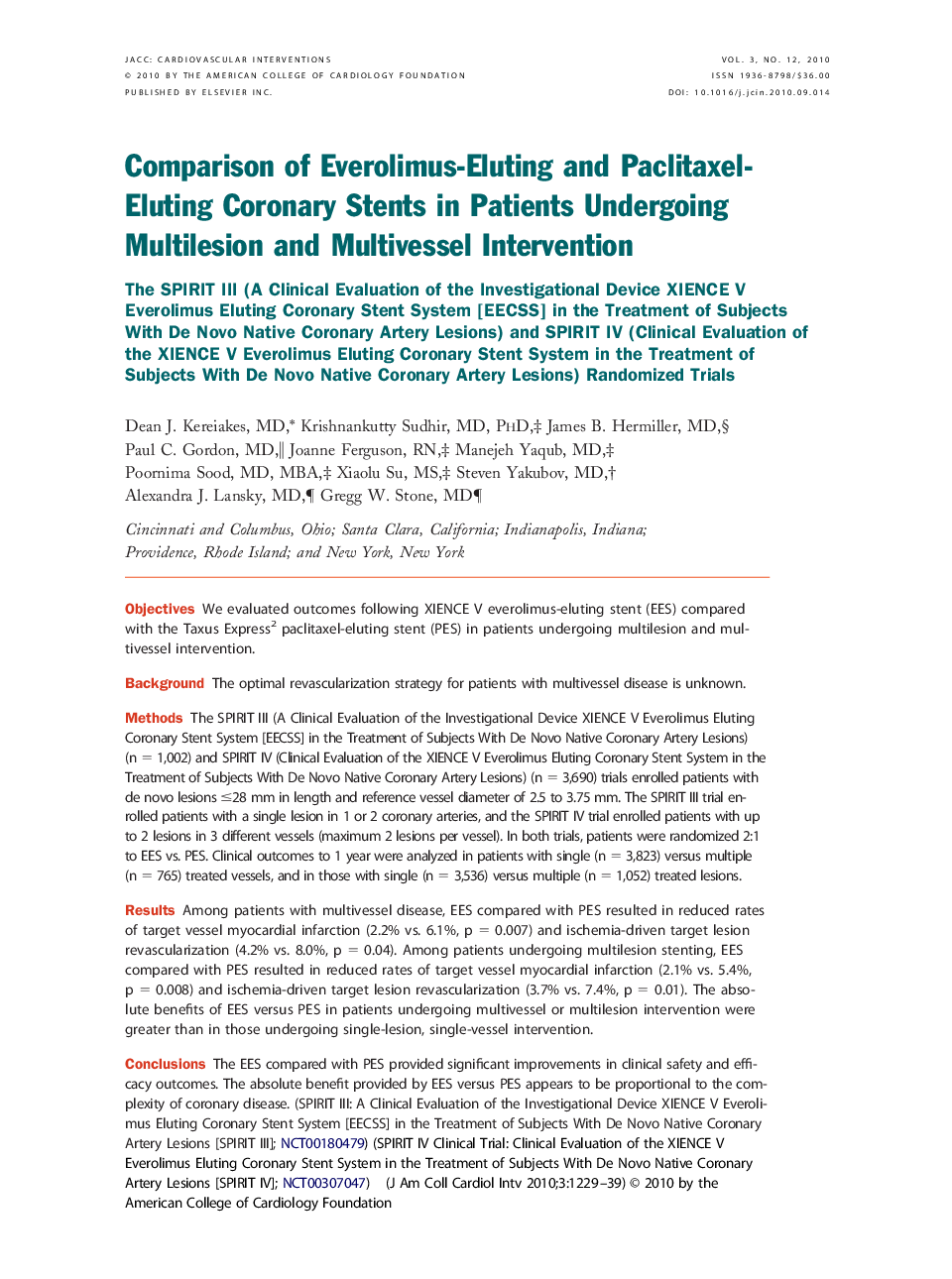| کد مقاله | کد نشریه | سال انتشار | مقاله انگلیسی | نسخه تمام متن |
|---|---|---|---|---|
| 2941981 | 1177095 | 2010 | 11 صفحه PDF | دانلود رایگان |

ObjectivesWe evaluated outcomes following XIENCE V everolimus-eluting stent (EES) compared with the Taxus Express2 paclitaxel-eluting stent (PES) in patients undergoing multilesion and multivessel intervention.BackgroundThe optimal revascularization strategy for patients with multivessel disease is unknown.MethodsThe SPIRIT III (A Clinical Evaluation of the Investigational Device XIENCE V Everolimus Eluting Coronary Stent System [EECSS] in the Treatment of Subjects With De Novo Native Coronary Artery Lesions) (n = 1,002) and SPIRIT IV (Clinical Evaluation of the XIENCE V Everolimus Eluting Coronary Stent System in the Treatment of Subjects With De Novo Native Coronary Artery Lesions) (n = 3,690) trials enrolled patients with de novo lesions ≤28 mm in length and reference vessel diameter of 2.5 to 3.75 mm. The SPIRIT III trial enrolled patients with a single lesion in 1 or 2 coronary arteries, and the SPIRIT IV trial enrolled patients with up to 2 lesions in 3 different vessels (maximum 2 lesions per vessel). In both trials, patients were randomized 2:1 to EES vs. PES. Clinical outcomes to 1 year were analyzed in patients with single (n = 3,823) versus multiple (n = 765) treated vessels, and in those with single (n = 3,536) versus multiple (n = 1,052) treated lesions.ResultsAmong patients with multivessel disease, EES compared with PES resulted in reduced rates of target vessel myocardial infarction (2.2% vs. 6.1%, p = 0.007) and ischemia-driven target lesion revascularization (4.2% vs. 8.0%, p = 0.04). Among patients undergoing multilesion stenting, EES compared with PES resulted in reduced rates of target vessel myocardial infarction (2.1% vs. 5.4%, p = 0.008) and ischemia-driven target lesion revascularization (3.7% vs. 7.4%, p = 0.01). The absolute benefits of EES versus PES in patients undergoing multivessel or multilesion intervention were greater than in those undergoing single-lesion, single-vessel intervention.ConclusionsThe EES compared with PES provided significant improvements in clinical safety and efficacy outcomes. The absolute benefit provided by EES versus PES appears to be proportional to the complexity of coronary disease. (SPIRIT III: A Clinical Evaluation of the Investigational Device XIENCE V Everolimus Eluting Coronary Stent System [EECSS] in the Treatment of Subjects With De Novo Native Coronary Artery Lesions [SPIRIT III]; NCT00180479) (SPIRIT IV Clinical Trial: Clinical Evaluation of the XIENCE V Everolimus Eluting Coronary Stent System in the Treatment of Subjects With De Novo Native Coronary Artery Lesions [SPIRIT IV]; NCT00307047)
Journal: JACC: Cardiovascular Interventions - Volume 3, Issue 12, December 2010, Pages 1229–1239